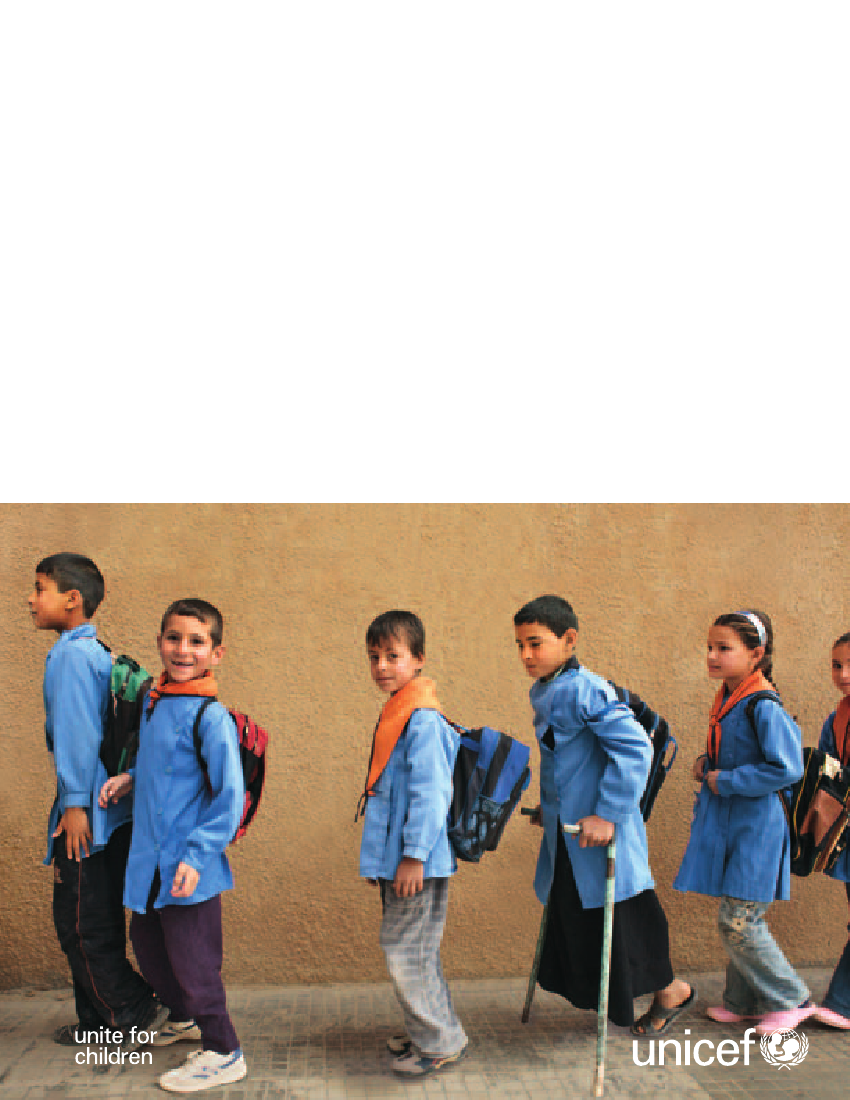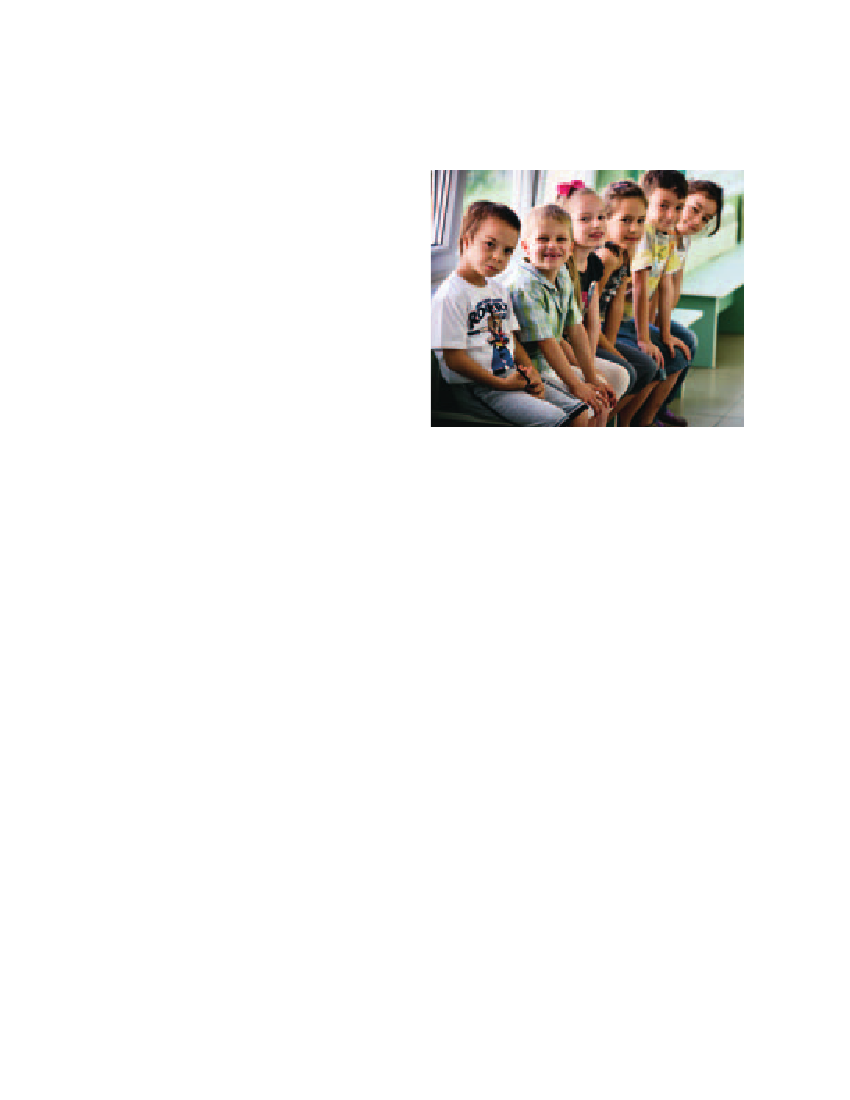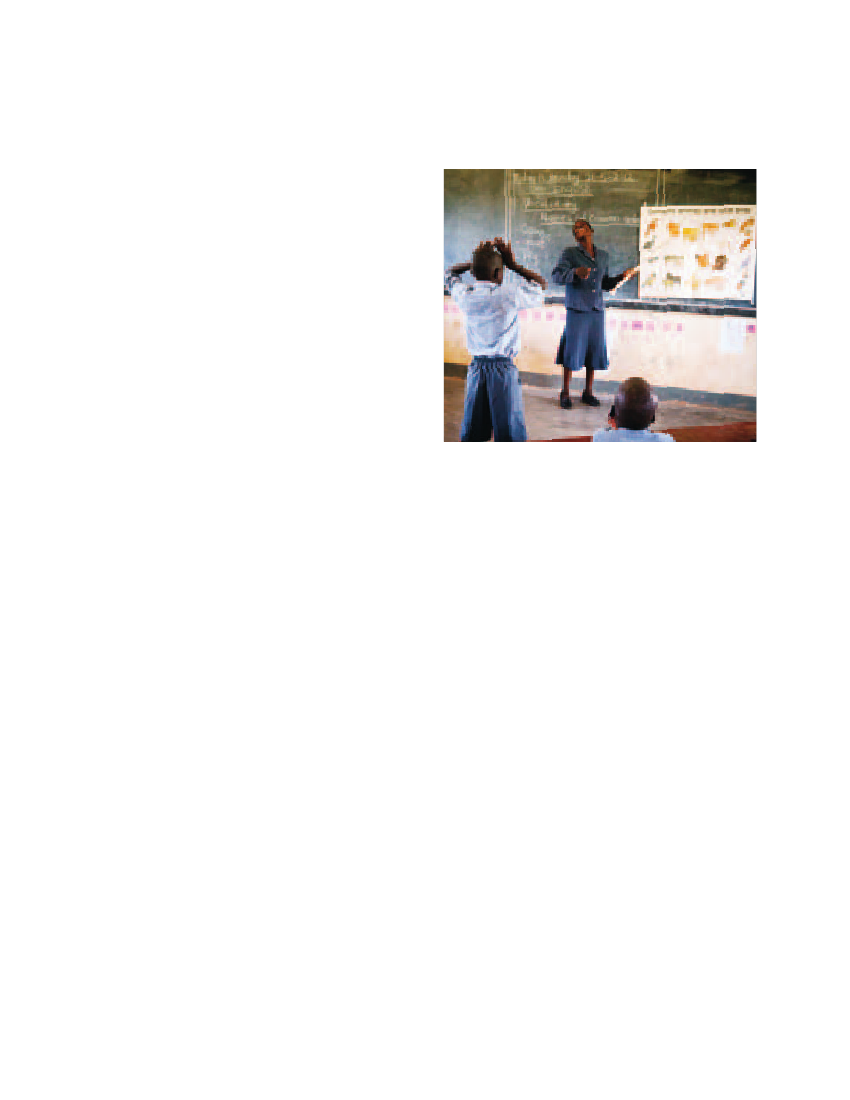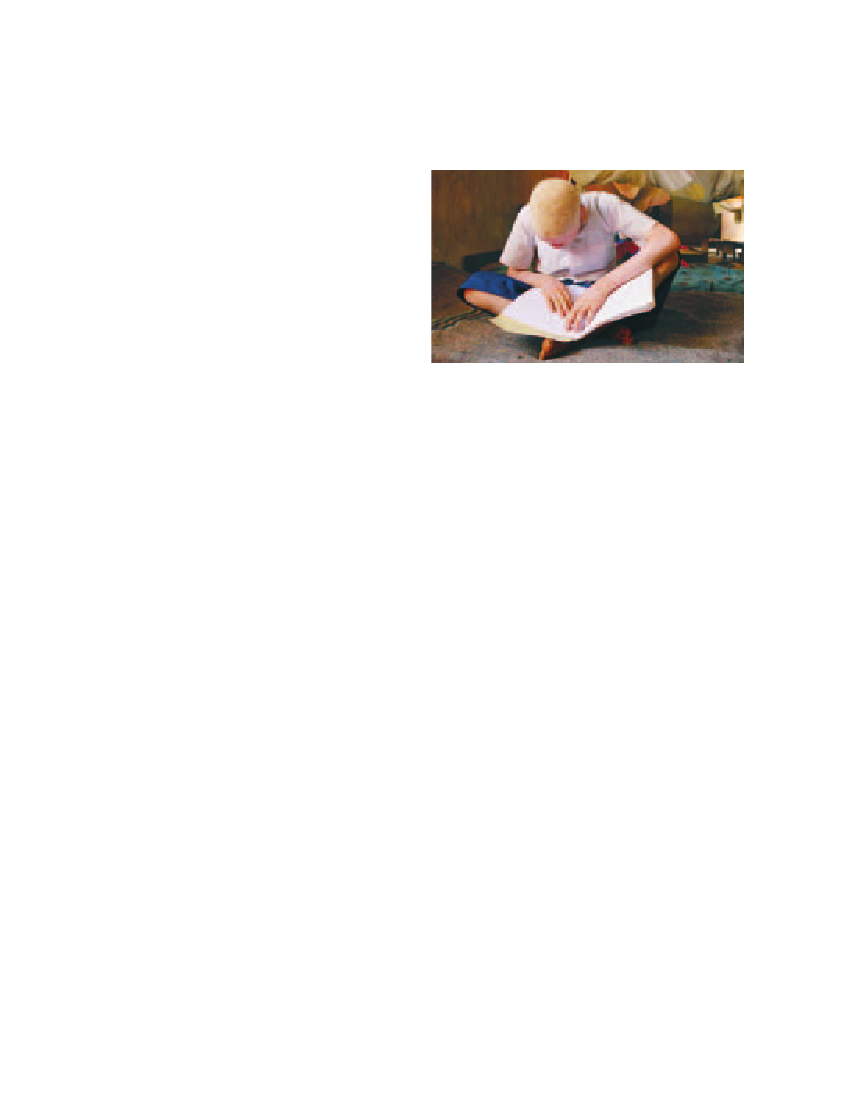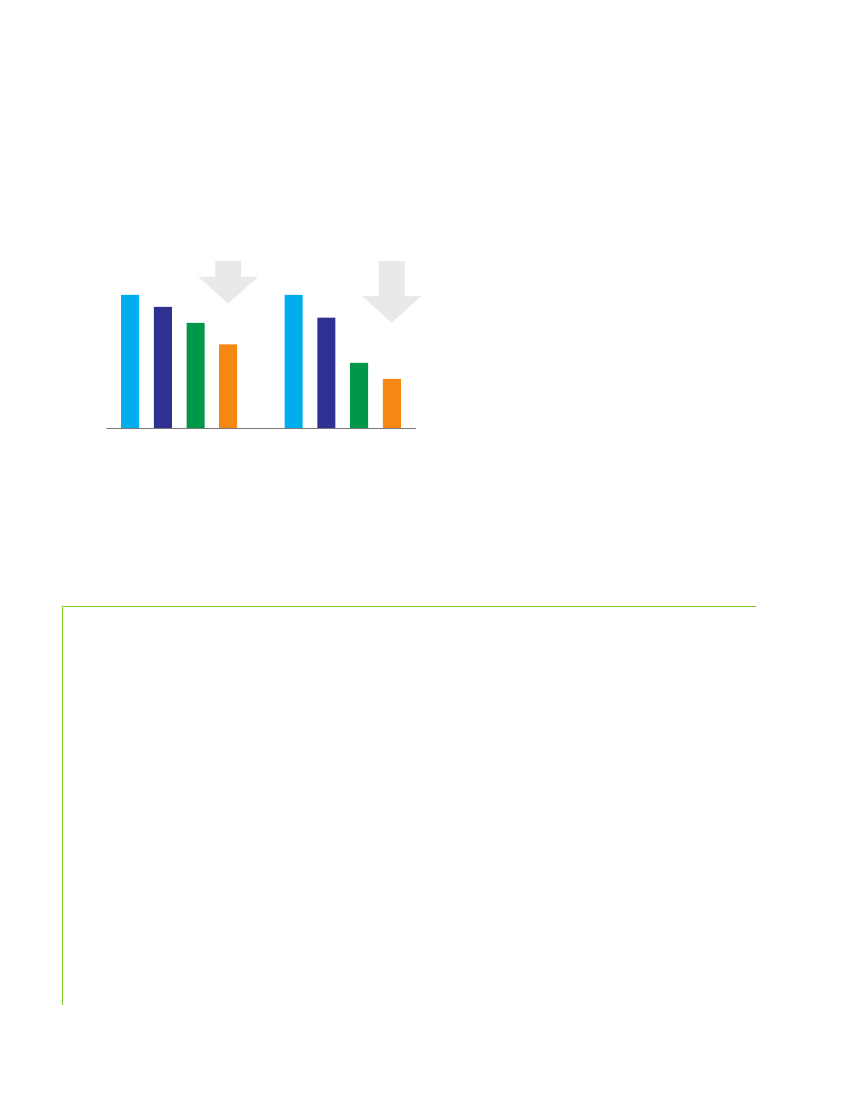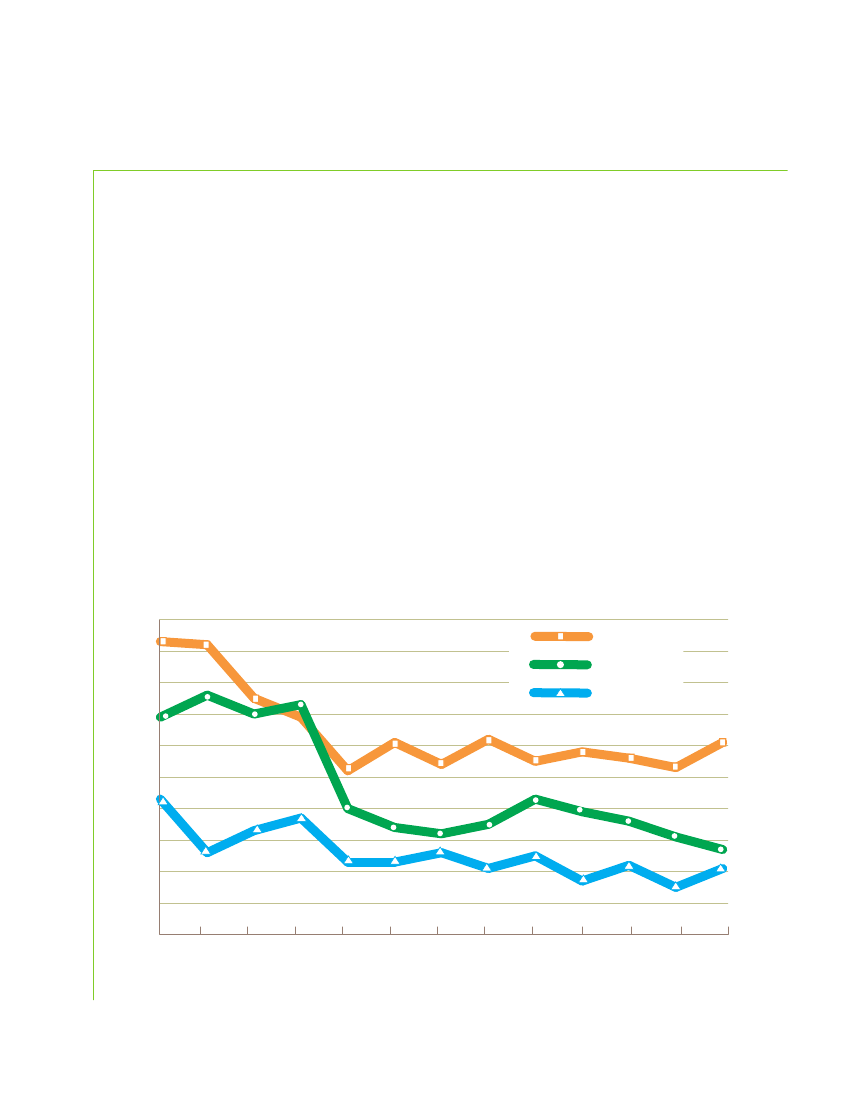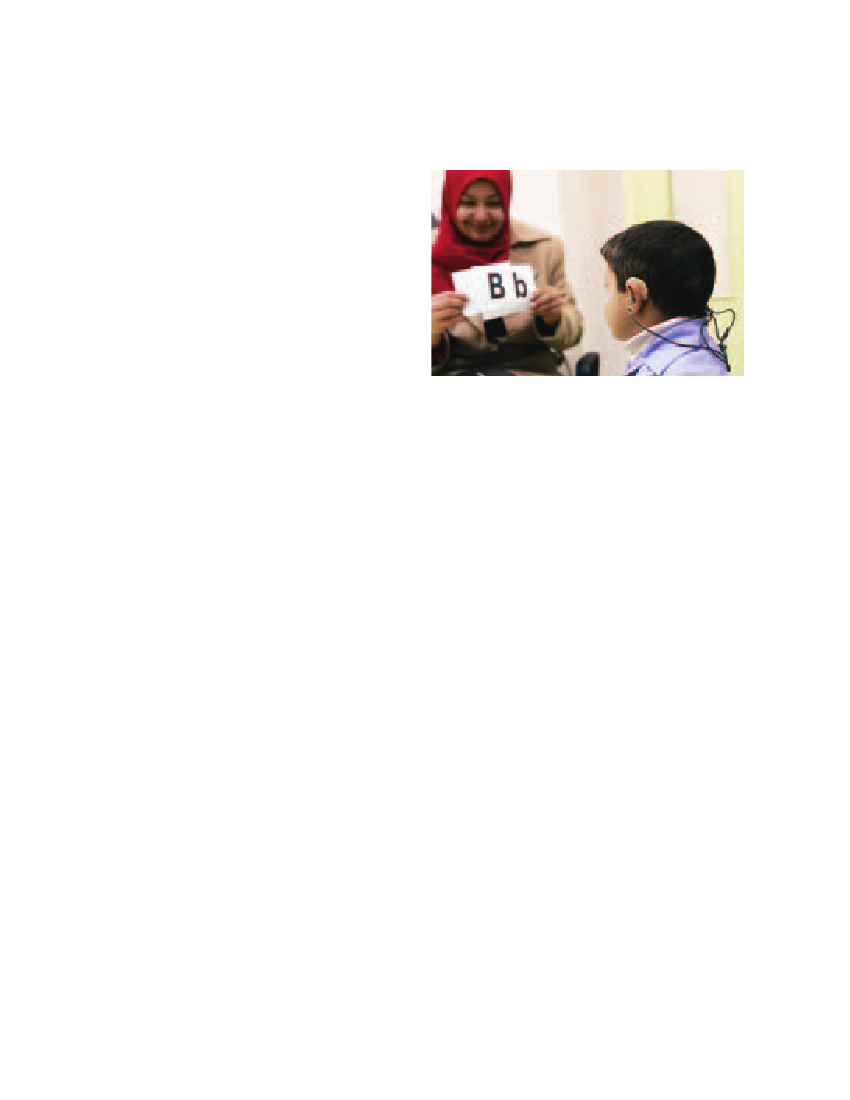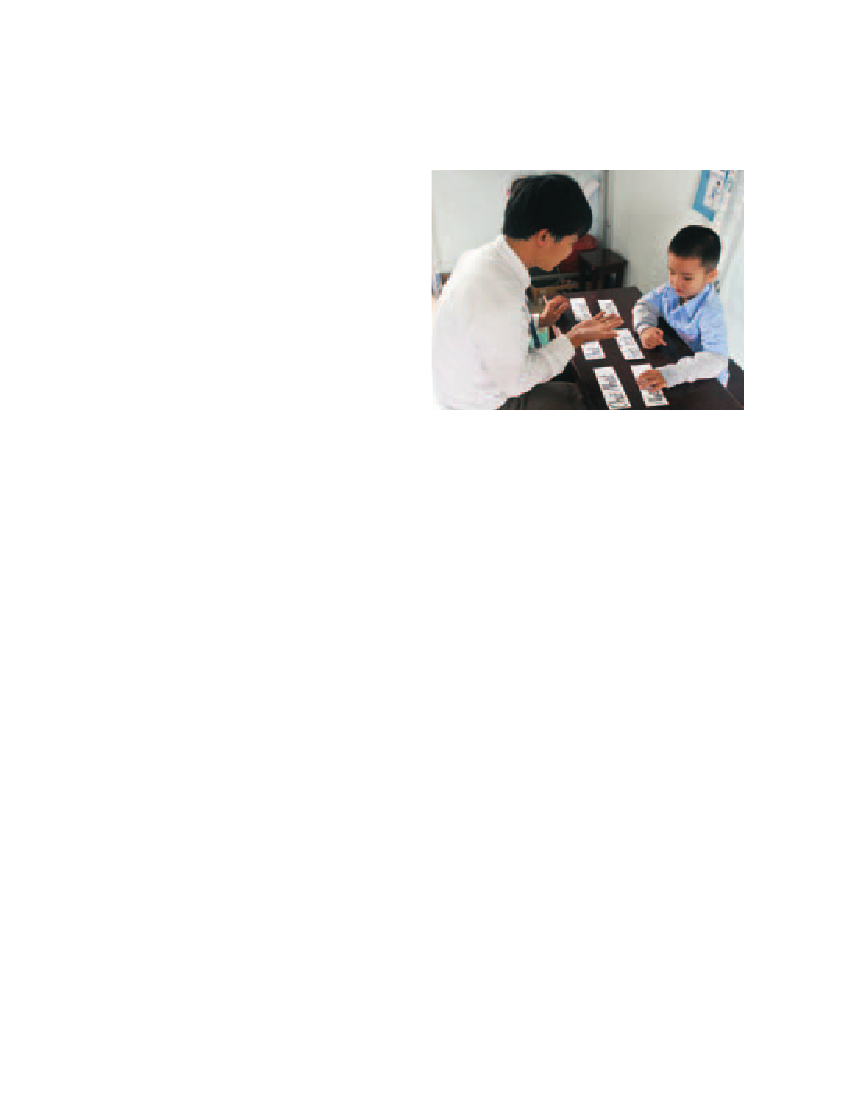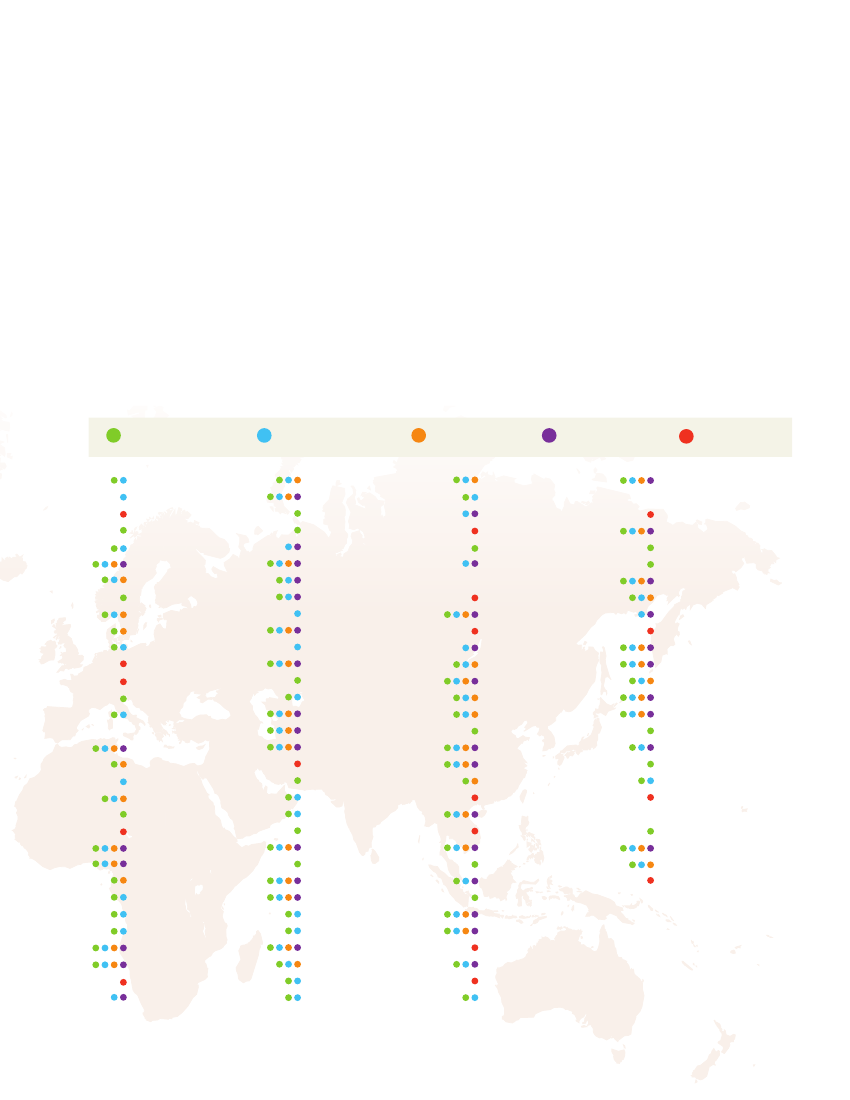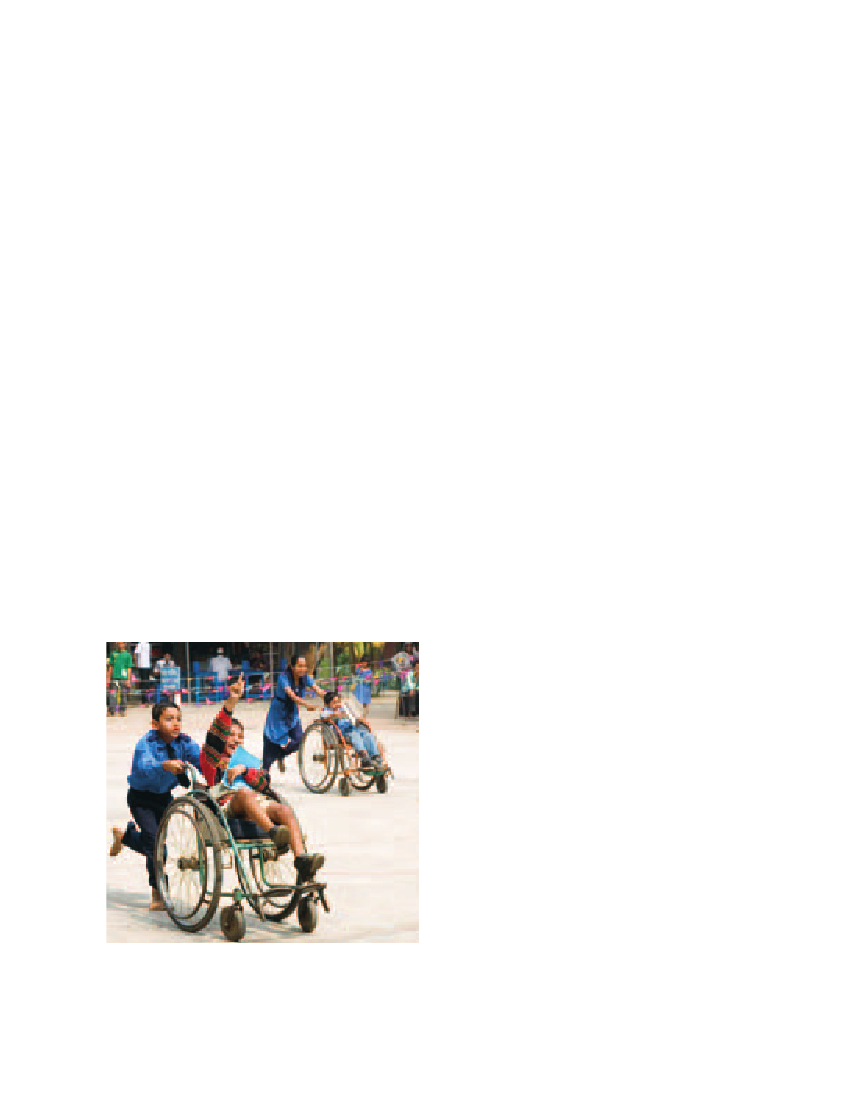Udenrigsudvalget 2012-13
URU Alm.del Bilag 185
Offentligt
THE STATE OF THE WORLD’S CHILDREN2013EXECUTIVE SUMMARY
Children withDisabilities
THE STATE OF THE WORLD’S CHILDREN2013CHILDREN WITH DISABILITIES
EXECUTIVE SUMMARYKey recommendationsInternational commitment to building more inclusive societies has resulted in improvements in thesituation of children with disabilities and their families, but too many of them continue to face barriersto their participation in the civic, social and cultural affairs of their communities. Realizing the promiseof equity through inclusion will require action to:
123456789
Ratify – and implement – the Convention on the Rights of Persons with Disabilities and theConvention on the Rights of the Child.Fight discrimination and enhance the awareness of disability among the general public, decision-makers, and those who provide essential services for children and adolescents in such fields ashealth, education and protection.Dismantle barriers to inclusion so that all children’s environments – schools, health facilities, publictransport and so on – facilitate access and encourage the participation of children with disabilitiesalongside their peers.End the institutionalization of children with disabilities, starting with a moratorium on newadmissions. This should be accompanied by the promotion of and increased support for family-based care and community-based rehabilitation.Support families so they can meet the higher costs of living and lost opportunities to earn incomeassociated with caring for children with disabilities.Move beyond minimum standards by involving children and adolescents with disabilities and theirfamilies in evaluating supports and services designed to meet their needs.Coordinate services across all sectors so as to address the full range of challenges facing childrenand adolescents with disabilities and their families.Involve children and adolescents with disabilities in making decisions that affect them – not just asbeneficiaries, but as agents of change.Promote a concerted global research agenda on disability to generate the reliable and comparabledata needed to guide planning and resource allocation, and to place children with disabilities moreclearly on the development agenda.
The ultimate proof of all global and national efforts will be local, the test being whether every childwith a disability enjoys her or his rights – including access to services, support and opportunities – ona par with other children, even in the most remote settings and the most deprived circumstances.
InTRoDUCTIonReports such as this typically begin with a statisticdesigned to highlight a problem. The girls and boysto whom this edition ofThe State of the World’sChildrenis dedicated are not problems. Rather, eachis a sister, brother or friend who has a favouritedish, song or game; a daughter or son with dreamsand the desire to fulfil them; a child with a disabilitywho has the same rights as any other girl or boy.Given opportunities to flourish as others might,children with disabilities have the potential to leadfulfilling lives and to contribute to the social, cul-tural and economic vitality of their communities.Yet surviving and thriving can be especially difficultfor children with disabilities. They are at greaterrisk of being poor than peers without disabilities.Even where children share the same disadvan-tages, children with disabilities confront additionalchallenges as a result of their impairments andthe many barriers that society throws in their way.Children living in poverty are among the least likelyto enjoy the benefits of education and health care,for example, but children who live in poverty andhave a disability are even less likely to attend thelocal school or clinic.In many countries, responses to the situation ofchildren with disabilities are largely limited to insti-tutionalization, abandonment or neglect. Theseresponses are the problem, and they are rooted innegative or paternalistic assumptions of incapacity,dependency and difference that are perpetuated byignorance. What is needed is a commitment to thesechildren’s rights and their futures, giving priority tothe most disadvantaged – as a matter of equity andfor the benefit of all.Children with disabilities encounter different formsof exclusion and are affected by them to varyingdegrees depending on the type of disability theyhave, where they live and the culture or class towhich they belong. Gender is also a crucial factor:Girls with disabilities are also less likely to get
Victor, a 13-year-old with cerebral palsy, has fun in the waterin Brazil. � Andre Castro/2012
an education, receive vocational training or findemployment than are boys with disabilities orgirls without disabilities.Children with disabilities are often regarded as infe-rior, and this exposes them to increased vulnerability:Discrimination based on disability has manifesteditself in marginalization from resources and decision-making, and even in infanticide. Exclusion oftenstems from invisibility. Few countries have reliableinformation on how many of their citizens are chil-dren with disabilities, what disabilities they haveor how these disabilities affect their lives. Childrenthus excluded are unknown to, and therefore cutoff from, public services to which they are entitled.These deprivations can have lasting effects – by lim-iting access to gainful employment or participationin civic affairs later in life, for example. But access toand use of supportive services and technology can
EXECUTIVE SUMMARY
1
position a child with a disability to take her or hisplace in the community and contribute to it.The future is far from grim. By their commitmentto upholding the Convention on the Rights of theChild (CRC) and the Convention on the Rights ofPersons with Disabilities (CRPD), governmentsaround the world have taken upon themselvesthe responsibility of ensuring that all children,irrespective of ability or disability, enjoy theirrights without discrimination of any kind. TheConventions bear witness to a growing globalmovement dedicated to the inclusion of childrenwith disabilities in community life. They estab-lish that children with disabilities have the samerights as others.Inclusion goes beyond integration. To take anexample from the field of education, integrationmight be attempted simply by admitting childrenwith disabilities to ‘regular’ schools. Inclusion,however, is possible only when schools aredesigned and administered so that all children canlearn and play together. This would entail provid-ing such needed accommodations as access toBraille, sign language and adapted curricula.Inclusion benefits everyone. To continue with theexample of education, ramps and wide doorways
can enhance access and safety for all children,teachers, parents and visitors, not just those whouse wheelchairs.In efforts to promote inclusion and fairness,children with disabilities should be able to enlistthe support of their families, disabled people’sorganizations, parents’ associations and com-munity groups. They should also be able to counton allies further afield. Governments have thepower to help by aligning their policies and pro-grammes with the CRPD and CRC. Internationalpartners can provide assistance compatible withthe Conventions. Corporations and other privatesector entities can advance inclusion – and attractthe best talent – by embracing diversity in hiring.Many of the deprivations endured by childrenwith disabilities stem from and are perpetuatedby their invisibility. The research communityis working to render more children visible byimproving data collection and analysis. Their workwill help to overcome ignorance and discrimina-tion, to target resources and interventions andgauge their effects. But decision-makers need notwait for better data to begin building more inclu-sive infrastructure and services: All that is neededis for these efforts to remain flexible so they canbe adapted as new data come to light.
On the numbersBy one widely used estimate, some 93 million children – or 1 in 20 of those aged 14 or younger – live with amoderate or severe disability of some kind.Such global estimates are essentially speculative. They are dated – this one has been in circulation since 2004– and derived from data of quality too varied and methods too inconsistent to be reliable. In order to provide acontext for and illustrate the issues under discussion,The State of the World’s Children 2013presents the resultsof national surveys and independent studies, but even these must be interpreted with caution and should not becompared to one another. This is because definitions of disability differ by place and time, as do study design,methodology and analysis.
2
THE STATE OF THE WORLD’S CHILDREN 2013: Children with Disabilities
FUnDAMEnTAlS oF InClUSIonThe CRC and CRPD challenge charitableapproaches that regard children with disabili-ties as passive recipients of care and protection.Instead, the Conventions demand recognition ofeach child as a full member of her or his fam-ily, community and society. This entails a focusnot on traditional notions of ‘rescuing’ the child,but on investment in removing the physical, cul-tural, economic, communication, mobility andattitudinal barriers that impede the realization ofthe child’s rights – including the right to activeinvolvement in making decisions that affectchildren’s daily lives.The underestimation of the abilities of peoplewith disabilities is a major obstacle to their inclu-sion and to the provision of equal opportunities.Dismissive attitudes exist throughout society –from professionals, politicians and other decision-makers to families and peers as well as peoplewith disabilities themselves, who in the absenceof evidence that they are valued and supportedwill often underestimate their own abilities.Six-year-old nemanja (far left) sits with classmates in noviSad, Serbia. His primary school was the first to integratechildren with disabilities under a law aimed at reducinginstitutionalization. � UnICEF/HQ2011-1156/Holt
Changing attitudeslittle will change in the lives of children withdisabilities unless attitudes change. Ignoranceabout the nature and causes of impairments,invisibility of the children themselves, seriousunderestimation of their potential and capaci-ties, and other impediments to equal opportunityand treatment all conspire to keep children withdisabilities silenced and marginalized. But bring-ing disability into political and social discoursemakes it possible to sensitize decision-makersand service providers as well as demonstrateto society at large that disability is part of thehuman condition.The importance of involving children with dis-abilities cannot be overstated. Prejudice can bereduced through interaction, as demonstrated by
activities that bring together children with andwithout disabilities. Social integration benefitseveryone, and children who have experiencedinclusion – in education, for example – can thenbe society’s best teachers in reducing inequali-ties and building an inclusive society.Inclusive media also have a key part to play. Byincluding nuanced portrayals of children andadults with disabilities, media can send out posi-tive messages that they are members of familiesand neighbourhoods and can also counter mis-representations and stereotypes that reinforcesocial prejudices.Similarly, participation in social activities helpsto promote a positive view of disability. Sport,in particular, has helped overcome many soci-etal prejudices. Seeing a child surmount thephysical and psychological barriers to partici-pation can be inspirational and can promoterespect – although care must be taken not tomake children with disabilities who do not
ExEcutivE Summary
3
perform such physical feats feel inferior to thosewho do.Sport has also been helpful in campaigns toreduce stigma, and athletes with disabilities areoften among the most recognized representativesof people with disabilities. Experiences in a num-ber of countries have shown that access to sportand recreation is not only of direct benefit to chil-dren with disabilities, but also helps to improvetheir standing in the community as they areseen to participate alongside other children inactivities valued by society.Because the CRPD recognizes the family as thenatural unit of society and puts the State inthe role of supporting it, the process of fulfillingthe rights of children with disabilities beginswith supporting their families and establishinga home setting conducive to early intervention.
experience poverty than those without disabili-ties. People with disabilities tended to be lesswell off in terms of education, employment, liv-ing conditions, consumption and health. Higherhealth-care costs than those of households with-out members with disabilities can further reducea household’s standard of living.States can tackle the increased risk of childpoverty with such social protection initiativesas cash transfer programmes, which have beenshown to benefit children. A growing number oflow- and middle-income countries are building onpromising results from broader efforts and havelaunched targeted social protection initiatives thatinclude cash transfers specifically for childrenwith disabilities. Routine monitoring and evalua-tion of the transfers’ effects on the health, educa-tional and recreational attainment of children withdisabilities will be essential to make sure theseprogrammes achieve their objectives.Another tool governments can use is disability-specific budgeting, whereby a government setsspecific goals for children with disabilities within abroader initiative and allocates a sufficient portionof the available resources towards them. Effectiveaccess to services including education, health care,habilitation, rehabilitation and recreation shouldbe provided free of change and in a manner thatpromotes the fullest possible social integrationand individual development of the child.
Supporting children and familiesUnder the CRPD, children with disabilities andtheir families have the right to an adequate stan-dard of living and are also entitled to such subsi-dized or free support services as day care, respitecare and access to self-help groups. Social pro-tection for children with disabilities and theirfamilies is especially important because thesefamilies often face a higher cost of living and lostopportunities to earn income. Estimates of theadditional costs of disability borne by familiesrange from 9 per cent of income in Viet nam to11–69 per cent in the United Kingdom. In addi-tion to medical, rehabilitation and other directexpenses, families also face opportunity costs,as parents and family members must oftengive up or limit their employment in order tocare for children with disabilities.A review of 14 developing countries found thatpeople with disabilities were more likely to
Community-based rehabilitationCommunity-based rehabilitation (CBR) pro-grammes – which seek to ensure that peoplewith disabilities have equal access to services andopportunities relating to health, education andlivelihoods – are an example of an interventionthat is designed and run by local communities –critically, with the active participation of childrenand adults with disabilities.
4
THE STATE OF THE WORLD’S CHILDREN 2013: Children with Disabilities
CBR can prove effective in addressing multipledeprivations, such as those facing children withdisabilities who live in rural and indigenouscommunities. In an outreach initiative for indig-enous children in oaxaca, Mexico, for example,CBR teams from the Centre for Research andPost-Secondary Studies in Social Anthropology,in collaboration with UnICEF, promoted theformation of local support networks amongthe families of children with disabilities. overthree years (2007–2010), the initiative saw theincreased acceptance of children with disabilitiesby their own families and communities, improvedprovision of social services, community-led con-struction of wheelchair ramps to public spaces,arrangements for free services from state andfederal hospitals, and 32 new enrolments ofchildren with disabilities in mainstream schools.Inclusive approaches are built around the con-cept of accessibility, with the aim of making themainstream work for everyone rather than creat-ing parallel systems. An accessible environmentis essential if children with disabilities are toenjoy their right to participate in the communityand to have the chance to realize their full poten-tial. So, for instance, children with disabilitiesneed access to all schools to reap the maximumbenefits of education. Children who are educatedalongside their peers have a much better chanceof becoming productive members of their societ-ies and of being integrated in the lives of theircommunities.Depending on the type of disability, a childmay need an assistive device (a prosthesis, forexample) or service (such as a sign languageinterpreter) to function fully in various aspectsof life. According to WHo, however, in manylow-income countries only 5–15 per cent ofthose who need assistive technology are ableto obtain it. The costs of such technology canbe prohibitive, especially for children, who need
their devices replaced or adjusted as they grow.Access to assistive technology and any otherspecialized support that children need to facilitatetheir interaction and participation should be freeand available to all.Universal design is an approach to accessibil-ity that seeks to create products, structures andenvironments that all people can use – regardlessof age, ability or situation – to the greatest extentpossible, without the need for adaptation or spe-cialized design. Real-world applications includecurb cuts, audio books, Velcro fastenings andlow-floor buses.The cost of integrating accessibility into newbuildings and infrastructure can be negligible,amounting to less than 1 per cent of the capitaldevelopment cost. By contrast, adaptations tocompleted buildings can reach as much as 20 percent of the original cost. It therefore makes senseto integrate accessibility considerations into proj-ects at the early stages of the design process.Accessibility should also be a considerationwhen funding development projects.
Wenjun, 9, walks with her foster mother in China.� UnICEF/China/2010/liu
ExEcutivE Summary
5
A STRonG FoUnDATIonInclusive health and education services have acritical role to play in building a solid foundationon which children with disabilities can buildfulfilling lives.
Inclusive healthUnder the CRC and the CRPD, all children havethe right to the highest attainable standard ofhealth. Children with disabilities are thus equallyentitled to the full spectrum of care – fromimmunization in infancy to proper nutrition andtreatment for childhood ailments and injuries,to confidential sexual and reproductive healthinformation and services during adolescenceand into early adulthood. Equally critical aresuch basic services as water, sanitation andhygiene (WASH).Ensuring that children with disabilities actuallyenjoy these rights on a par with others is theobjective of an inclusive approach to health. It isa matter of social justice and of respecting theinherent dignity of all human beings, as well asan investment in the future – as healthy childrengrow into more effective producers and parents.Immunizations, among the most successful andcost-effective public health interventions, are akey component of global efforts to reduce child-hood illness and death. More children than everbefore are being reached – but children with dis-abilities are still not benefiting from increasedcoverage. Including these children in immuniza-tion efforts is not only ethical but also imperativefor public health and equity; universal coveragecannot be reached if they remain excluded.While immunization can pre-empt some diseasesthat lead to disabilities, it is no less importantto immunize children who are already disabled.Denied the full range of immunizations, childrenwith disabilities are at risk of developmental
A teacher with a hearing impairment teaches a class ofhearing-impaired children in Gulu, Uganda.� UnICEF/UGDA2012-00108/Sibiloni
delays, avoidable secondary conditions andpreventable death.Including children with disabilities in efforts topromote immunization – for example, raisingawareness by showing them alongside othersin posters and other promotional materials, andreaching out to parents and disabled people’sorganizations – will help to increase immuniza-tion coverage among them.nutrition is also critical. Insufficient food or a dietshort of certain vitamins and minerals can leaveinfants and children vulnerable to specific condi-tions and a host of infections that can lead tophysical, sensory or intellectual disabilities. Forexample, between 250,000 and 500,000 childrenare considered to be at risk of becoming blindeach year from vitamin A deficiency. This syn-drome is easily prevented by oral supplementa-tion costing just a few cents per child. Similarly,low-cost measures are available to prevent dis-abilities arising from other nutritional deficiencies.
6
THE STATE OF THE WORLD’S CHILDREN 2013: Children with Disabilities
Poor nutrition and episodes of diarrhoea inearly childhood can lead to stunting, indicatedby low height for age, which in turn can resultin poor cognitive and educational performancethat will have consequences throughout life.Malnutrition in mothers can contribute to anumber of preventable childhood disabilities.one of the most prevalent causes of disabilityin the world is anaemia, which affects approxi-mately 42 per cent of pregnant women inlow- and middle-income countries (over halfsuffer iron deficiency anaemia); it also affectsmore than half of preschool-aged children indeveloping countries.While malnutrition can be a cause of disability,it can also be a consequence. Indeed, childrenwith disabilities are at heightened risk of mal-nutrition. Physical impairments associated withconditions such as cleft palate or cerebral palsymay interfere with the mechanics of consumingfood; certain conditions, such as cystic fibrosis,may impede nutrient absorption; and someinfants and children with disabilities may needspecial diets or increased calorie intake tomaintain a healthy weight.Yet children with disabilities may be hiddenaway from community screening and feedinginitiatives. Those who do not attend schoolmiss out on school feeding programmes. Inaddition to physical factors, attitudes may alsoadversely affect a child’s nutrition. In somesocieties, mothers may not be encouraged tobreastfeed a child with a disability; disabledchildren may be fed less, denied food or pro-vided with less nutritious food than siblingswithout disabilities. Children with some typesof physical or intellectual disabilities may havedifficulty feeding themselves. It is probable thatin some cases what is assumed to be disability-associated ill health and wasting may in fact beconnected with feeding problems.
Throughout the developing world, persons withdisabilities routinely face particular difficulties inaccessing safe drinking water and basic sanita-tion. Facilities are often physically inaccessible,and in some places, new ones are still beingdesigned and built without adequate concern forchildren with disabilities. Even though low-cost,low-tech interventions such as step latrines areincreasingly available, information about themhas yet to be widely disseminated and incorpo-rated into WASH policies and practice.Social barriers also impede access. Children withdisabilities often face stigma and discriminationwhen using household and public facilities, forexample, because of unfounded fears that theywill contaminate them. When children withdisabilities, especially girls, are forced to useseparate facilities, they are at increased risk ofaccidents and physical attack, including rape.Children with disabilities might not attend schoolfor want of an accessible toilet; they often reporttrying to eat and drink less to cut down on thenumber of visits to the toilet – thus endangeringtheir nutritional status.Children and young people with disabilities havebeen almost entirely overlooked in sexual andreproductive health and HIV/AIDS programmes,as they are often incorrectly believed to be sexu-ally inactive, unlikely to use substances and at lessrisk of violence than their peers without disabili-ties. Many young people with disabilities do notreceive even basic information about how theirbodies develop and change, and because they areoften taught to be silent and obedient, they are atheightened risk of abuse. In consequence, they areat increased risk of HIV infection.People with disabilities of all ages who areHIV-positive are less likely to receive appropri-ate services than peers without disabilities, as
ExEcutivE Summary
7
facilities and programmes rarely consider theirneeds, while health-care personnel lack disability-specific training.Because children develop rapidly during thefirst three years of life, early detection and inter-vention are crucial for those with disabilities.Developmental screening is an effective meansof detecting disability in children and referringthem to further assessment and intervention –for example to treat iron deficiency, administeranti-epileptic drugs or provide community-basedrehabilitation – as well as of providing vital infor-mation to family members. Such interventionsare becoming increasingly available in low- andmiddle-income countries.The detection and treatment of impairments isnot a separate area of medicine but an integralaspect of public health. When policymakers andresearchers characterize these measures as beingin competition for resources with measures to
promote the health of people without disabilities,they perpetuate discrimination and inequity.Health-care services available to children withdisabilities may be of poor quality. Health work-ers and other professionals stand to benefitfrom being educated about child developmentand disability and from being trained to deliverintegrated services, with the participation of theextended family where possible. Additionally, thefeedback of children with disabilities should besolicited so that facilities and services can bettermeet their needs.
Inclusive educationChildren with disabilities are disproportionatelydenied their right to education, which under-mines their ability to enjoy the full rights of citi-zenship, find gainful employment and take upvalued roles in society. Household survey datafrom 13 low- and middle-income countries showthat children with disabilities aged 6–17 years aresignificantly less likely to be enrolled in schoolthan their peers without disabilities.As long as children with disabilities are deniedequal access to their local schools, governmentscannot achieve universal primary education(Millennium Development Goal 2), and Statesparties to the CRPD cannot fulfil their responsi-bilities under Article 24.Rather than segregating children with disabilitiesin special schools, inclusive education entailsproviding meaningful learning opportunities toall students within the regular school system.Ideally, it allows children with and without dis-abilities to attend the same age-appropriateclasses at the local school, with additional, indi-vidually tailored support as needed. It requiresphysical accommodation as well as a new, child-centred curriculum that includes representations
Estimated rates of primaryschool completionwithdisabilitywithoutdisability
51%61%42%53%
withdisabilitywithoutdisability
Source:World Health organization, based on surveys in 51 countries.
8
THE STATE OF THE WORLD’S CHILDREN 2013: Children with Disabilities
of the full spectrum of people found in societyand reflects the needs of all children.Studies across countries show a strong linkbetween poverty and disability, which is in turnlinked to gender, health and employment issues.Children with disabilities are often caught in acycle of poverty and exclusion: Girls becomecaregivers to siblings rather than attend school,for example, or the whole family may be stigma-tized, leading to a reluctance to report that a childhas a disability or to take the child out in public.Education of those who are excluded or margin-alized, however, brings about poverty reduction.The first steps towards inclusion are taken athome during the early years. Without the love,sensory stimulation, health care and social inclu-sion to which they are entitled, children can missimportant developmental milestones and theirpotential may be unfairly limited, with significantsocial and economic implications for themselves,their families and their communities.A child whose disability or developmental delayis identified at an early stage will have a muchbetter chance of reaching her or his full capacity.Early childhood education is important because80 per cent of the brain’s capacity develops beforethe age of 3; the period before primary schoolprovides opportunities to tailor developmentaleducation to the child’s individual needs. Studiessuggest that the children who are at greatest dis-advantage stand to benefit most. With family andcommunity support from the earliest days of theirlives, children with disabilities are better placedto make the most of their school years and toprepare themselves for adulthood.In school, creating an inclusive and enablinglearning environment for children with disabili-ties depends in large part on teachers having aclear understanding of inclusive education and
a commitment to teaching all children. All toooften, teachers lack appropriate preparation andsupport in teaching children with disabilitiesin regular schools, and this contributes to theirstated unwillingness in many countries to sup-port the inclusion of children with disabilities intheir classes.Resources for children with disabilities tend tobe allocated to segregated schools rather thanto an inclusive mainstream education system.This is not only inappropriate, but can also provecostly: In Bulgaria, for instance, the budget perchild educated in a special school can be up tothree times higher than that for a similar childin a regular school.When teachers and personnel are trained toconsider disability-related issues, they lookupon inclusion of children with disabilities morepositively. The most positive attitudes of allhave been found among teachers with actualexperience of inclusion. It has been shown thatpositive attitudes among teachers translate intoless restrictive placements for students withdisabilities.Yet pre-service training rarely prepares teachersto teach inclusively, and existing training is of vari-able quality. The lack of people with disabilitiesamong teaching personnel presents another chal-lenge to inclusive education; adults with disabili-ties often face considerable obstacles to qualifyingas teachers. In Cambodia, for instance, teachersmust by law be “free of disabilities.”Partnerships with civil society are providingencouraging examples of ways to enhanceteacher training and diversity. In Mozambique,the national nGo Ajuda de Desenvolvimento dePovo para Povo has worked with the nationaldisabled persons’ organization ADEMo to trainstudent teachers to work with children with
ExEcutivE Summary
9
disabilities and to train student teachers whohave disabilities.Inclusive education requires a flexible approach toschool organization, curriculum development andpupil assessment. Such flexibility would allow forthe development of a more inclusive pedagogy,shifting the focus from teacher-centred to child-centred to embrace diverse learning styles.Teachers often have inadequate support in theclassroom, and they need to be able to call onspecialist help – for instance, with Braille orcomputer-based instruction – when the needs oftheir students with disabilities are beyond theirexpertise. Such specialists are in short supply,especially in such low-income areas as sub-Saharan Africa. This presents an opportunity forappropriate support from providers of financialand technical assistance from the internationalto the local level.Inclusive education also needs to draw uponresources from outside the classroom. Parentshave the potential to contribute in many ways,from providing accessible transport to raisingawareness to liaising with the health and socialsectors to obtain equipment, support and grants.The most underused resource in schools andcommunities all over the world is the childrenthemselves. Although the importance of childagency and child participation is well docu-mented, they sit uncomfortably within existingstructures and systems of education. Involvingchildren with disabilities in decisions can beparticularly challenging, not least because ofingrained thinking and behaviour that perceivesthem as passive victims.In participatory research, children frequentlyhighlight the importance of a clean environmentand hygienic toilets; for children with disabilities,
privacy and accessibility are paramount. Childrenwith disabilities can and must guide and evalu-ate efforts to advance accessibility and inclusion.After all, who better to understand the meansand impact of exclusion?Aspirations for inclusive education are more like-ly to be realized if governments and their part-ners are clear about who is to do what and how,and to whom they are expected to report. Wherepolicies fail to be implemented, the problemmay be one of unclear mandates. In Bangladesh,for example, most aspects of the education ofchildren with disabilities are managed by theMinistry of Social Welfare rather than that ofEducation. To make inclusive education a reality,Ministries of Education should be encouraged totake responsibility for all children of school age.Coordination with partners and stakeholders canplay a strong supporting role in this process.Exclusion denies children with disabilities the life-long benefits of education: a better job, social andeconomic security, and opportunities for full par-ticipation in society. In contrast, investment in theeducation of children with disabilities can contrib-ute to their future effectiveness as members of thelabour force. Indeed, a person’s potential incomecan increase by as much as 10 per cent with eachadditional year of schooling.Furthermore, basic reading and writing skills alsoimprove health: A child born to a mother who canread is 50 per cent more likely to survive past theage of 5, and lower maternal education has beenlinked to higher rates of stunting among childrenin urban slums in Kenya, Roma settlements inSerbia, and in Cambodia.Education is both a useful instrument and a right.As stated in the CRC, it promotes “the develop-ment of the child’s personality, talents and men-tal and physical abilities to their fullest potential.”
10
THE STATE OF THE WORLD’S CHILDREN 2013: Children with Disabilities
ESSEnTIAlS oF PRoTECTIonChildren with disabilities are among the mostvulnerable members of society. They stand tobenefit the most from measures to count them,protect them against abuse and guarantee themaccess to justice.In societies where they are stigmatized and theirfamilies exposed to social or economic exclusion,many children with disabilities are not even able toobtain an identity document. This is a violation ofthese children’s human rights and a fundamentalbarrier to their participation in society. It can sealtheir invisibility and increase their vulnerability tothe many forms of exploitation that result from nothaving an official identity.States parties to the CRPD have the clear obliga-tion to guarantee effective legal protection forchildren with disabilities. To change discriminatorysocial norms, States need to make sure existinglaws are enforced and that children with disabili-ties are informed about their right to protectionfrom discrimination, and how to exercise thisright. The principle of ‘reasonable accommodation’dictates that necessary and appropriate adapta-tions be made so that children with disabilities canenjoy their rights on an equal basis with others.Relegating them to separate systems would beinappropriate; equity through inclusion is the goal.Discrimination against and exclusion of childrenwith disabilities renders them disproportionatelyvulnerable to violence, neglect and abuse. Someforms of violence are specific to children withdisabilities. It may be perpetrated in the guise oftreatment for behaviour modification, for example,using electric shocks or drugs. Girls with disabili-ties in many countries are subject to forced steril-ization or abortion.In many countries, children with disabilities con-tinue to be placed in institutions. It is rare for thesefacilities to provide the individual attention that
A young boy with albinism reads Braille at school in thetown of Moshi, United Republic of Tanzania.� UnICEF/HQ2008-1786/Pirozzi
children need to develop to their full capacity. Theeducational, medical and rehabilitative care theyreceive in such places is often insufficient, owingto either low standards or inadequate monitoring.Separating children with disabilities from theirfamilies is a violation of their right to be cared forby their parents unless this is deemed by a com-petent authority to be in the individual child’s bestinterests. If immediate family is unable to care fora child, the CRPD obligates State parties to providealternative care within the extended family or com-munity, for instance in a foster family.Where countries have sought to return institution-alized children to their families and communities,children with disabilities have been among the lastto be released. Such was the case, for example,in Serbia, although the realization that reformshad bypassed children with disabilities in the pastdecade has since added vigour to such efforts(seechart, page 12).A State’s responsibility to protect the rights of allchildren under its jurisdiction also extends to chil-dren with disabilities who are in contact with thelaw – whether as victims, witnesses, suspects or
ExEcutivE Summary
11
Last to benefitUnder Serbia’s welfare reforms, children withdisabilities were released from institutions at aslower rate than children without disabilities.100%91%79%63%49%37%83%decrease
37%
100%
decrease
63%
convicts. Specific measures can help: Children canbe interviewed in the appropriate signed or spokenlanguages; all professionals involved in the admin-istration of justice, from law enforcement officersto judges, can be trained to work with childrenwho have disabilities; and regulations and proto-cols can be established to ensure equal treatmentof children with disabilities.Furthermore, it is important to develop alternativesolutions to formal judicial proceedings, taking intoaccount the range of children’s individual capaci-ties. Children with disabilities should also not beplaced in regular juvenile detention facilities; rather,they should be provided appropriate treatment toaddress the issues that led them to commit a crime.Such treatment should be carried out in appropriatefacilities with adequately trained staff, with humanrights and legal safeguards fully respected.
2000
2005
2008
2011
2000
2005
2008
2011
Children and youth (0–26 years old)with disabilities in institutions
Children and youth (0–26 years old)without disabilities in institutions
Source:Republican Institute for Social Protection, Serbia.Sample sizes: Children and youth (0–26 years old) with disabilities: 2,020 in2000, 1,280 in 2011. Children and youth (0–26 years old) without disabilities:1,534 in 2000, 574 in 2011.
Violence against children with disabilitiesChildren with disabilities are three to four times more likely to be victims of violence. Research teams atliverpool John Moores University and the World Health organization have conducted a systematic review andmeta-analysis of existing studies of violence against children with disabilities. The review considered 17 studiesfrom high-income countries, in the absence of high-quality studies from low- and middle-income countries.Estimates of risk indicated that children with disabilities were at significantly higher risk of experiencingviolence than peers without disabilities: 3.7 times more likely for combined measures of violence, 3.6 timesfor physical violence and 2.9 times for sexual violence. Children with mental or intellectual disabilities werefound to be 4.6 times more likely to be victims of sexual violence than peers without disabilities.Why are children with disabilities at greater risk of violence? Several explanations have been put forward:First, caring for a child with a disability can put extra strain on caregivers, increasing the risk of abuse. Second,significant numbers of children with disabilities are still placed in residential care, a major risk factor for sexualand physical abuse. Finally, impairments affecting communication render some children particularly vulnerable,as they may not be able to disclose abusive experiences.All children with disabilities should be viewed as a high-risk group in which it is critical to identify violence. Theymay benefit from interventions – such as home visits and training in parenting skills – that have proven effectivein preventing violence or mitigating its consequences among children without disabilities.
12
THE STATE OF THE WORLD’S CHILDREN 2013: Children with Disabilities
HUMAnITARIAn RESPonSEHumanitarian crises, such as those stemmingfrom warfare or natural disasters, pose particu-lar risks for children with disabilities. Inclusivehumanitarian response is urgently needed –and feasible.Armed conflict is a major cause of disabilityamong children, whom it affects in direct andindirect ways. Children sustain physical injuriesfrom attack, artillery fire and landmine explosions– including after conflicts have ended; they alsosuffer psychological effects from these injuries orfrom witnessing traumatic events. Indirect effectsinclude illnesses untreated when health servicesbreak down and malnutrition that develops whenfood becomes scarce. Children may also be sepa-rated from their families, their homes and theirschools, sometimes for years.Similar deprivations can ensue as a result ofnatural disasters, which – particularly as thoserelated to climate change increase in severity andfrequency – are expected to affect ever greaternumbers of children and adults in coming years.Children with disabilities face particular chal-lenges in emergencies. They may be excludedfrom or unable to access mainstream supportservices and assistance programmes, such ashealth services or food distribution, because ofphysical barriers posed by inaccessible buildingsor negative attitudes. They may be forgotten inthe establishment of targeted services and dis-regarded in early warning systems, which oftendo not take into account the communication andmobility requirements of those with disabilities.Disability-inclusive humanitarian action isinformed by and grounded in:• A rights-based approach. Article 11 of theCRPD specifically calls on duty bearers to takeall necessary measures to protect persons withdisabilities in emergencies.
Vijay, 12, survived a landmine explosion and has gone onto become a mine risk educator in Sri lanka.� UnICEF/Sri lanka/2012/Tuladar
• An inclusive approach that recognizes thatin addition to their disability-specific needs,children with disabilities have the same needsas other children, and that also addresses thebarriers, physical and otherwise, that impedetheir participation in regular programmes.• Ensuring accessibility and universal design ofinfrastructure and information.• Promoting independent living and participa-tion in all aspects of life for children withdisabilities.• Integrating age, gender and diversity aware-ness, with special attention to the discrimina-tion faced by girls and women with disabilities.This approach calls for holistic and inclusive pro-grammes, rather than just isolated projects andpolicies targeting disabilities. Key interventionsinclude:• Improving data and assessments in order tohave an evidence base for the distinct needsand priorities of children with disabilities.• Making mainstream humanitarian servicesaccessible for children with disabilities andinvolving them in planning and design.• Designing specialized services for children
ExEcutivE Summary
13
with disabilities and ensuring that recoveryand reintegration processes foster well-being,health, self-respect and dignity.• Taking measures to prevent injuries and abuseand promote accessibility.• Partnering with community, regional andnational actors, including disabled persons’organizations, to challenge discriminatory atti-tudes and perceptions and promote equity.• Promoting participation of children with disabil-ities by consulting them and creating opportu-nities for their voices to be heard.
Parties to conflict have an obligation to protectchildren from the effects of armed violence andto provide them with access to appropriate healthand psychosocial care to aid their recovery andreintegration. The Committee on the Rights of theChild has recommended that States parties tothe Convention add explicit reference to childrenwith disabilities as part of their broader commit-ment not to recruit children into armed forces.
Risk, resilience and inclusive humanitarian actionChildren with disabilities and their families face particular challenges in emergencies. They may have to contendwith new environmental barriers such as collapsed ramps; damaged or lost assistive devices; and the loss of suchservices as sign language interpreters or visiting nurses.If family members die, there may be no one left who knows how to care for a child with a physical disability orwho can communicate with a child with a sensory impairment. Fleeing families may leave behind children whoare unable to walk or are in frail health – or they may abandon a child out of fear that they will be refused asylumin another country that excludes people with disabilities. Institutions and residential schools may close or beabandoned by staff, leaving the children in their charge without care.In armed conflict, children with disabilities, especially those with learning disabilities, may be pressed into serviceas fighters, cooks or porters, because they are considered to be less valuable or less likely to resist than childrenwithout disabilities. Programmes aimed at the reintegration of child ex-combatants might not serve the needs ofchildren with disabilities, who therefore remain marginalized and excluded, often having to beg, as has been thecase in liberia and Sierra leone.Children with disabilities should be given the opportunity to take part in the planning and implementation ofdisaster risk reduction and peace-building strategies as well as in disaster response and recovery processes. Thishas begun to happen as demonstrated by efforts in Pakistan and Haiti.Disability is being mainstreamed into such emergency guidelines as the Sphere Project’sHumanitarian Charter andMinimum Standards in Humanitarian Response.Such progress should be extended to such areas as child nutritionand protection, and the extent to which children with disabilities are included in humanitarian response must beaudited to monitor and improve results.
14
THE STATE OF THE WORLD’S CHILDREN 2013: Children with Disabilities
Explosive remnants of warExplosive remnants of war (ERW) and anti-personnel landmines represent a significant contributingfactor to child disability. Such instruments as the 1997 Mine Ban Treaty have helped to reduce theoverall number of people killed or injured by these weapons, but the percentage of children amongtotal casualties has increased.Annually since 2005, children have accounted for approximately 20–30 per cent of casualties, and there havebeen at least 1,000 child casualties each year since monitoring began in 1999. In 2010, children accounted for55 per cent of all civilian deaths, making them the civilian group for whom landmines and ERW are most deadly.In some of the world’s most mine-affected countries, such as Afghanistan and Cambodia, the percentage ofcasualties represented by children is even higher(see chart).Since 2008, boys have made up the single largest casualty group, accounting for about half of all civiliancasualties; that year, they represented 73 per cent of child casualties. In many contaminated countries, boysare more likely than girls to come across mines or ERW because they are more involved in outdoor activities(continued on p. 16)
Child casualties in the most affected countries*Percentage of children among civilian casualties (1999–2011)100%90%80%70%60%50%40%30%20%10%0%1999200020012002200320042005200620072008200920102011
AfghanistanCambodiaColombia
* The three States parties to the Mine Ban Treaty with the highest annual casualty rates.Source:landmine and Cluster Munition Monitor.
ExEcutivE Summary
15
Explosive remnants of war(continued from p. 15)
such as herding livestock, gathering wood or food, or collecting scrap metal. They are also more likely than girlsto tamper with any devices they find.Children in general are more likely to deliberately handle explosive devices than adults, often unknowingly,out of curiosity or mistaking them for toys. Well-planned risk education is therefore especially important forchildren.More than one third of all blast survivors require amputation; the percentage can be expected to be higher forchildren, given their smaller size. Children’s physical rehabilitation is more complex than that of adults: Becausetheir bones grow faster than their soft tissue, they may need several re-amputations. Prostheses must be adjustedor replaced as they grow.The psychological consequences of an ERW or landmine blast are often devastating for a child’s development.They can include feelings of guilt, loss of self-esteem, phobias and fears, sleep disorders and an inability to speak.If left untreated, children may develop long-term mental disorders.The social and economic reintegration needs of child survivors also vary considerably from those of adults. Inmany countries, child survivors are forced to cut short their education owing to the time needed for recovery orthe financial burden that rehabilitation places on their families. They may be physically unable to walk to schooland lack access to alternative transportation; classrooms may not be accessible, and teachers may not be trainedto consider their needs. Access to free education for children with disabilities as a result of landmine or ERWinjuries is necessary both to promote a sense of normalcy in their lives and to reintegrate them with their peergroup and allow them to fully participate in society.Few victim assistance programmes address age- and gender-specific concerns. In a 2009 survey of morethan 1,600 survivors from 25 affected countries conducted by Handicap International, almost two thirds ofrespondents reported that services for children were “never” or “almost never” adapted to their specificneeds or age.As children account for an increasing percentage of the total civilian casualties from ERW and landmines, itis essential to implement specific policy and programmatic recommendations that meet their needs. Theseshould include measures to disaggregate data on casualties by age and gender; to train health and educationprofessionals to consider the needs of child survivors; and to bolster victim assistance, overall, as a key pillarof response to the impact of ERW, with guidelines that specifically pertain to children.
16
THE STATE OF THE WORLD’S CHILDREN 2013: Children with Disabilities
MEASURInG CHIlD DISABIlITYA society cannot be equitable unless all childrenare included, and children with disabilities can-not be included unless sound data collection andanalysis render them visible.Measuring child disability presents a unique setof challenges. Because children develop andlearn to perform basic tasks at different speeds, itcan be difficult to assess function and distinguishsignificant limitations from variations in normaldevelopment. The varying nature and severityof disabilities, together with the need to applyage-specific definitions and measures, furthercomplicate data collection efforts.In addition, the poor quality of data on childdisability stems, in some cases, from a limitedunderstanding of what disability is in children,and in other cases, from stigma or insufficientinvestment in improving measurement. The lackof evidence that results from such difficultieshinders the development of good policies andthe delivery of vital services.While there is general agreement that definitionsof disability should incorporate both medical andsocial determinants, the measurement of disabil-ity is still predominantly medical, with a focus onspecific physical and mental impairments.one framework for considering health and dis-ability within a broader context of social barriersis the International Classification of Functioning,Disability and Health (ICF), developed by theWorld Health organization. This classificationregards disability in two main ways: as a mat-ter of the body’s structure and functions, and interms of the person’s activity and participation.Disability, as defined by the ICF, is an ordinarypart of human existence – every person canexperience some degree of it. The ICF definitionalso recognizes that functioning and disabilityoccur in context, and therefore it is meaningful
A health worker assesses a boy at the Atfaluna Societyfor Deaf Children, State of Palestine. The organizationoffers education and vocational training, free healthcare, psychosocial services and job placement.� UnICEF/HQ2008-0159/Davey
to assess not only bodily but also societal andenvironmental factors.Derived from the ICF, the InternationalClassification of Functioning, Disability andHealth for Children and Youth (ICF-CY) takes astep towards incorporating the social dimensionby capturing not only the impairment but also itseffect on children’s functioning and participationin their environment. It covers four main areas:body structures (e.g., organs, limbs), body func-tions (e.g., listening, remembering), limitationson activity (e.g., walking, dressing) and restric-tions on participation (e.g., playing with otherchildren, performing simple chores).Data on disability should be interpreted in con-text. Prevalence estimates are a function of bothincidence and survival. Where child mortalityrates are high, low reported disability prevalencemay be the consequence of low survival rates foryoung children with disabilities – or it may reflectthe failure to count children who live in institu-tions, are hidden away by families, or live andwork on the streets.
ExEcutivE Summary
17
Culture also plays an important role. The inter-pretation of what may be considered ‘normal’functioning varies across contexts and influencesmeasurement outcomes. The attainment of cer-tain milestones may not only vary among chil-dren, but differ also by culture, as children maybe encouraged to experiment with new activitiesat different stages of development. Reference val-ues must therefore be set with consideration oflocal circumstances and understanding.For these reasons, assessment tools developedin high-income countries, such as the WechslerIntelligence Scale for Children, cannot be indis-criminately applied in other countries or com-munities. Frames of reference may vary, andsurvey tools may fail to sufficiently capture local
customs, cultural understanding, languagesand expressions.Furthermore, the specific objectives of the data col-lection are likely to influence the definition of whatconstitutes ‘disability’, the questions asked and theresulting figures. For instance, the criteria used todefine eligibility for a disability benefit are likelyto be more restrictive than criteria for a surveyconducted to identify all persons with a functionallimitation, yielding dramatically different numbers.Many children are identified as having a disabilitywhen they come into contact with education orhealth-care systems. But in low-income coun-tries or communities, school and clinic staff maynot be able to routinely recognize or register the
Lessons learnedSince 1995, UnICEF has supported more than 100 low- and middle-income countries in conducting MultipleIndicator Cluster Surveys (MICS) to track progress in children’s and women’s well-being. Since 2000–2001, some ofthese surveys have included a module designed to screen child disability, and this information is now being builtupon to design an improved measurement tool.The standard disability module used in MICS between 2000 and 2010 is the Ten Questions Screen (TQ), which wasdeveloped in 1984 and reflects how disability was understood at the time. The process starts by asking the primarycaregivers of children aged 2–9 years for a personal assessment of the physical and mental development andfunctioning of the children in their care; responses are either positive or negative, with no room for nuances.The validity of the TQ approach has been widely tested, but the results must be interpreted with caution. The TQ isa screening tool and requires follow-up medical and developmental assessment in order to yield a reliable estimateof the number of children in a given population who have disabilities. Few countries have had the budgets orcapacity to conduct the second-stage clinical assessment to validate results, and they have been further hamperedby the lack of a standardized methodology for conducting that assessment.Applying the TQ during the 2005–2006 MICS yielded a wide range of results across participating countries. Thepercentage of children screening positive for disability ranged from 3 per cent in Uzbekistan to 48 per cent in theCentral African Republic. It is not clear whether this variance reflected true differences among the populationssampled or additional factors. For instance, the low reported rate in Uzbekistan may have reflected a largepopulation of children with disabilities living in institutions, which are not subject to household surveys.
18
THE STATE OF THE WORLD’S CHILDREN 2013: Children with Disabilities
presence of children with disabilities. The result-ing paucity of information on children with dis-abilities in low-income countries has contributedto a misconception that disability does not meritglobal priority.General data collection instruments – such ascensus or household surveys – are likely tounderestimate the number of children with dis-abilities, particularly if the surveys do not ask
specifically about them. Targeted householdsurveys that do so have produced more accu-rate results than those that ask about disabilityin general, without reference to children. Morenumerous and detailed questions on the subjecttend to produce higher prevalence rates.To accurately report child disability, the choiceof questions must be tailored to a child’s age inorder to reflect the developmental stages and
From screening to assessmentChild disability measurement experts agree that screening efforts must be followed by in-depth assessments.Experiences in Bhutan, Cambodia and the former Yugoslav Republic of Macedonia provide important lessonsfor the measurement of child disability and adaptation of methodology to local context. They also testify to thetransformative power of data collection.The composition of the core assessment team and the type of tools used were adapted to local capacity. At the timeof the study, both Bhutan and Cambodia faced a shortage of qualified assessors. In Cambodia, mobile assessmentteams were employed and a hearing specialist was brought in from abroad, while in Bhutan emphasis was put ontraining mid-level professionals.The assessments demonstrated that tools such as questionnaires and tests must be locally validated and culturallyappropriate. Careful attention must be paid to language – for instance, in finding appropriate linguistic equivalentsfor the concepts of ‘impairment’ and ‘disability’.With assessment comes the potential for immediate intervention. In Cambodia, for example, some childrenwho screened positive for hearing impairment were found to have ear infections or a build-up of ear wax.once identified, these conditions were easily treated and more serious secondary infections and longer-termimpairments prevented.Assessment can also aid awareness-raising and spark change even while the processes of collecting and analysingdata are still under way. When assessments in Bhutan showed a higher incidence of mild cognitive disabilitiesamong children from poorer households and with less educated mothers, the government decided to focus onearly childhood development and childcare services in rural areas, where income and education levels are lower.A strategy for intervention on behalf of children identified as having a disability should be incorporated in theassessment from the earliest stages of planning. Such a strategy should include a mapping of the availableservices, the development of referral protocols and the preparation of informative materials for families onhow to adjust children’s surroundings to enhance functioning and participation in home and community life.
ExEcutivE Summary
19
evolving capacities of children. Given the com-plexity of developmental processes during thefirst two years of life, it can be difficult to distin-guish disability from variations in normal devel-opment without specialized tools or assessment.Many data collection instruments are basedsolely on the responses of parents, who may nothave knowledge of the specific benchmarks usedto evaluate children at each stage of develop-ment. Parents may report difficulties that stemfrom temporary conditions, such as ear infec-tions, and they may also overlook certain signs,or hesitate to report them because of a lack ofacceptance or stigma surrounding disability intheir culture.Efforts to measure child disability represent anopportunity to link assessment with interventionstrategies. Though early intervention is critical,capacity and resources for follow-up assessmentand support for children who screen positive fordisability are often scarce.
Data that capture the type and severity of children’sdisabilities as well as the barriers to children’sfunctioning and community participation, whencombined with relevant socio-economic indicators,help to inform decisions about how to allocateresources, eliminate barriers, design and provideservices, and meaningfully evaluate such inter-ventions. For instance, data can be used to mapwhether income, gender or minority status affectsaccess to education or immunization for childrenwith disabilities. Regular monitoring makes itpossible to assess whether initiatives designedto benefit children are meeting their goals.There is a clear need to harmonize child disabilitymeasurement in order to produce estimates thatare reliable, valid and internationally comparable.However, the currently fragmented state of childdisability data collection is no excuse to defermeaningful action towards inclusion; as new dataand analyses emerge, they will present opportuni-ties to adapt existing and planned programmesfor children with disabilities and their families.
A way forwardUnICEF, in partnership with the Washington Group on Disability Statistics and a broad array of stakeholders, isholding consultations to improve the methodology used to measure child disability in Multiple Indicator ClusterSurveys and other data collection efforts, in order to produce nationally comparable figures and promote theharmonization of data on child functioning and disability internationally.The screening tool under development covers children aged 2–17 years and uses a rating scale to assess speechand language, hearing, vision, learning (cognition and intellectual development), mobility and motor skills,emotions, and behaviours; it also includes aspects of children’s ability to participate in a range of activities andsocial interactions. Also in development is a standardized overall methodology for a more in-depth assessmentof disability in children, with data collection protocols, assessment tools and a framework analysis.Recognizing that specialists may be in short supply in some areas, a toolkit is being designed to enable teachers,community workers and other trained professionals to administer the new methodology. This will serve tostrengthen local capacity to identify and assess children with disabilities who are at risk of social exclusionand reduced participation.
20
THE STATE OF THE WORLD’S CHILDREN 2013: Children with Disabilities
An AGEnDA FoR ACTIonAs the nations of the world have repeatedlyaffirmed their commitment to building moreinclusive societies, the situation of many childrenwith disabilities and their families has improved.But progress has varied across countries, and toomany children with disabilities continue to facebarriers to their participation in the civic, social andcultural affairs of their communities. Realizing thepromise of equity through inclusion will requireaction in numerous areas and by many actors.
Ratify and implement theConventionsAs 2013 began, 127 countries and the EuropeanUnion had ratified the CRPD and 193 had ratifiedthe CRC, thereby showing a commitment to alltheir citizens.Ratification alone will not be enough; honouringcommitments in practice will require not onlydiligent enforcement but also rigorous monitoring,accountability and adaptation. The process willrequire effort on the part of national govern-ments, local authorities, employers, disabledpeople’s organizations and parents’ associations.International organizations and donors canalign their assistance with these internationalinstruments.
nguyen, who has autism, attends a class specifically tailoredto his needs at the Da nang Inclusive Education ResourceCentre in Viet nam. Such centres were set up to help childrenprepare for admission to inclusive mainstream schools.� UnICEF/Viet nam/2012/Bisin
conducting awareness-raising campaigns, andthey are also required to provide information tochildren and their families on how to prevent andreport exploitation, violence and abuse.International agencies and their government andcommunity partners can help overcome prejudiceby providing officials and public servants with adeeper understanding of the rights, capacities andchallenges of children with disabilities. Parents’organizations can play a pivotal role and shouldbe reinforced so that children with disabilities arevalued, cherished and supported by their familiesand communities.Discrimination on the grounds of disability is aform of oppression. The establishment of a clear,legal entitlement to protection from discriminationis vital in reducing the vulnerability of children withdisabilities. Where legislation banning discrimina-tion does not exist, disabled people’s organizationsand civil society as a whole will continue to have acrucial role to play in pressing for such laws.
Fight discriminationDiscrimination lies at the root of many of thechallenges confronted by children with disabilitiesand their families. Affirmations of equal rights andnon-discrimination in law and policy need to becomplemented by efforts to enhance awareness ofdisability among the general public, starting withthose who provide essential services for children insuch fields as health, education and protection.States parties to the CRPD and the United nationsand its agencies have committed themselves to
ExEcutivE Summary
21
Dismantle barriers to inclusionAll children’s environments – schools, health facili-ties, public transport and so on – can be built tofacilitate access and encourage the participationof children with disabilities alongside their peers.When children interact and understand eachother across levels of ability, they all benefit.Universal design – which promotes usabilityby all people to the greatest extent possible
– should be applied to the construction of allpublic and private infrastructure, as well as tothe development of inclusive school curricula,vocational training programmes, and childprotection laws, policies and services.Governments have the decisive role to play inintroducing and implementing the legislative,administrative and educational measures neces-sary to protect children with disabilities from all
Convention on the Rights of Persons with Disabilities andOptional Protocol: Signatures and ratifications
155SIGNED THECONVENTION*AfghanistanAlbaniaAlgeriaAndorraAngolaAntigua and BarbudaArgentinaArmeniaAustraliaAustriaAzerbaijanBahamasBahrainBangladeshBarbadosBelarusBelgiumBelizeBeninBhutanCOUNTRIES HAVE
128RATIFIED THECONVENTION*COUNTRIES HAVE
91SIGNED THEPROTOCOLCOUNTRIES HAVE
76RATIFIED THEPROTOCOLCosta RicaCôte d’IvoireCroatiaCubaCyprusCzech RepublicDemocratic People’sRepublic of KoreaDemocratic Republicof the CongoDenmarkDjiboutiDominicaDominican RepublicEcuadorEgyptEl SalvadorEquatorial GuineaEritreaEstoniaCOUNTRIES HAVE
27COUNTRIES HAVE
NOT SIGNEDEthiopiaFijiFinlandFranceGabonGambiaGeorgiaGermanyGhanaGreeceGrenadaGuatemalaGuineaGuinea-BissauGuyanaHaitiHondurasHungaryIcelandIndia
Bolivia (Plurinational State of)Bosnia and HerzegovinaBotswanaBrazilBrunei DarussalamBulgariaBurkina FasoBurundiCambodiaCameroonCanadaCape VerdeCentral African RepublicChadChileChinaColombiaComorosCongoCook Islands
*Includes the European Union.Source:Un Enable; United nations Treaty Collection. For notes on terms used, see p. 25.
22
THE STATE OF THE WORLD’S CHILDREN 2013: Children with Disabilities
forms of exploitation, violence and abuse. It isnot appropriate to create separate systems forchildren with disabilities – the goal must be inclu-sive, high-quality protection mechanisms suitableand accessible to all children.one such mechanism is birth registration, anessential element of protection. Efforts to registerchildren with disabilities – and thereby renderthem visible – deserve priority.
End institutionalizationInstitutions are poor substitutes for a nurturinghome life, even if they are well run and monitored.Immediate measures to reduce overreliance onthem could include a moratorium on new admis-sions. This should be accompanied by the promo-tion of and increased support for family-basedcare and community-based rehabilitation. Makingpublic services, schools and health systems
Signed ConventionIndonesiaIran (Islamic Republic of)IraqIrelandIsraelItalyJamaicaJapanJordanKazakhstanKenyaKiribatiKuwaitKyrgyzstanLao People’sDemocratic RepublicLatviaLebanonLesothoLiberiaLibyaLiechtensteinLithuaniaLuxembourgMadagascarMalawiMalaysiaMaldivesMaliMaltaMarshall IslandsMauritania
Ratified Convention
Signed Protocol
Ratified Protocol
Not signedThe former Yugoslav Republicof MacedoniaTimor-LesteTogoTongaTrinidad and TobagoTunisiaTurkeyTurkmenistanTuvaluUgandaUkraineUnited Arab EmiratesUnited KingdomUnited Republic of TanzaniaUnited StatesUruguayUzbekistanVanuatuVenezuela (BolivarianRepublic of)Viet NamYemenZambiaZimbabwe
MauritiusMexicoMicronesia (Federated States of)MonacoMongoliaMontenegroMoroccoMozambiqueMyanmarNamibiaNauruNepalNetherlandsNew ZealandNicaraguaNigerNigeriaNiueNorwayOmanPakistanPalauPanamaPapua New GuineaParaguayPeruPhilippinesPolandPortugalQatarRepublic of KoreaRepublic of Moldova
RomaniaRussian FederationRwandaSaint Kitts and NevisSaint LuciaSaint Vincent and theGrenadinesSamoaSan MarinoSao Tome and PrincipeSaudi ArabiaSenegalSerbiaSeychellesSierra LeoneSingaporeSlovakiaSloveniaSolomon IslandsSomaliaSouth AfricaSouth SudanδSpainSri LankaSudanδSurinameSwazilandSwedenSwitzerlandSyrian Arab RepublicTajikistanThailand
EXECUTIVE SUMMARY
23
accessible and responsive to the needs of childrenwith disabilities and their families will reduce thepressure to send children away in the first place.
programmes can be adapted so that families car-ing for children with disabilities are not excludedor offered insufficient support.
Support familiesDisability in the family is often associated withhigher costs of living and lost opportunities toearn income, and thus may increase the risk ofbecoming or remaining poor. Poverty makes itharder for children to obtain needed servicesand assistive technology.Social policies should take into account the mon-etary and time costs associated with disability.These can be offset with social grants, subsidiesfor transportation or funding for personal assis-tants or respite care. Cash benefits are easier toadminister, more flexible at meeting particularneeds, and also respect the decision-making rightsof parents and children. Existing cash transfer
Move beyond minimum standardsExisting supports and services should be continu-ally assessed with a view to achieving the bestpossible quality – not just meeting minimumstandards. Attention needs to focus on servingthe individual child as well as transforming entiresystems and societies.In this process of evaluation, the importance ofparticipation by children with disabilities andtheir families cannot be overstated. Children andyoung people with disabilities are among the mostauthoritative sources of information on what theyneed and whether their needs are being met.
Coordinate services to supportthe childThe effects of disability cut across sectors, requir-ing coordinated services to address the full rangeof challenges facing children with disabilitiesand their families. A coordinated programme ofearly intervention across the health, education andwelfare sectors would help to promote the earlyidentification and management of childhood dis-abilities. Earlier interventions have been shownto lead to larger gains in functional capacity, andremoving barriers earlier in life lessens the com-pounding effect of the multiple barriers faced bychildren with disabilities.Improvements in ability will have greater impact ifschool systems are willing and able to accept chil-dren with disabilities and meet their needs, whileinclusive school-to-work programmes as well aseconomy-wide efforts to promote the employmentof people with disabilities will make acquiring aneducation more meaningful for them.
Children with and without disabilities participate inschool festivities in Bangladesh.� UnICEF/BAnA2007-00655/Siddique
24
THE STATE OF THE WORLD’S CHILDREN 2013: Children with Disabilities
Conventions, optional protocols, signatures and ratificationsAConventionis a formal, multilateral agreement between many States parties.AnOptional Protocolto a Convention is a legal instrument intended to supplement the original agreement byestablishing additional rights or obligations. Such a protocol is optional in the sense that States parties to aConvention are not automatically bound by its provisions, but must ratify it independently. Thus, a State maybe party to a Convention but not to its optional Protocols.In most cases, a State becomes party to a Convention by following two steps: signature and ratification.Bysigning a Convention,a State indicates its intention to take steps to examine the Convention and itscompatibility with domestic law. A signature does not create a legal obligation to be bound by a Convention’sprovisions, but it indicates that a State will not take actions that would undermine the purpose of the Convention.Ratificationis the concrete action by which a State agrees to be legally bound by the terms of a Convention. Theprocedure varies according to each country’s particular legislative structure. In some cases, a state willaccedeto aConvention or optional Protocol. Essentially,accessionis like ratifying without first having to sign.More detailed definitions are available at<http://treaties.un.org/Pages/overview.aspx?path=overview/definition/page 1_en.xml>.The Convention on the Rights of Persons with Disabilities is available at<http://treaties.un.org/doc/Publication/CTC/Ch_IV_15.pdf>.The Optional Protocol is available at<http://treaties.un.org/doc/Publication/CTC/Ch-15-a.pdf>.
Involve children with disabilities inmaking decisionsChildren and adolescents with disabilities belongat the centre of efforts to build inclusive societies –not just as beneficiaries, but as agents of change.They are uniquely qualified to provide informationon whether their needs are being met.States parties to the CRC and CRPD haveaffirmed the right of children with disabilities toexpress their views on matters concerning themand to be consulted when legislation and policiesconcerning them are developed and implement-ed. To that end, decision-makers will need tocommunicate in ways and using means that areeasily accessed and used by children and youngpeople with disabilities.The right to be heard applies to all children.A child who is able to express herself or himselfis much less likely to be abused or exploited.Participation is especially important for such mar-ginalized groups as children who live in institutions.
Global promise, local testIn order to fulfil the promises of the CRPD and theCRC, international agencies and donors and theirnational and local partners can include childrenwith disabilities in the objectives, targets andmonitoring of all development programmes.Reliable and objective data are important to assistin planning and resource allocation and to placechildren with disabilities more clearly on thedevelopment agenda. To give impetus to the nec-essary statistical work, international donors canpromote a concerted global research agenda ondisability. In the meantime, programmes and bud-gets can be designed to allow for modifications asadditional information is made available.The ultimate proof of all global and national effortswill be local, the test being whether every childwith a disability enjoys her or his rights – includingaccess to services, support and opportunities – ona par with other children, even in the most remotesettings and the most deprived circumstances.
ExEcutivE Summary
25
“
Somewhere, a child is being told he cannot play because hecannot walk, or another that she cannot learn because she cannotsee. That boy deserves a chance to play. And we all benefit whenthat girl, and all children, can read, learn and contribute.The path forward will be challenging. But children do not acceptunnecessary limits. Neither should we.Anthony LakeExecutive Director, UnICEF
”
Cover photograph:Schoolchildren queue to enter their classroom in this 2007 photographfrom the Syrian Arab Republic. � UNICEF/HQ2007-0745/NooraniDesign by Prographics, Inc.United Nations Children’s Fund3 United Nations PlazaNew York, NY 10017[email protected]www.unicef.org/sowc2013� United Nations Children’s Fund (UNICEF)May 2013To read this report online,scan this QR code or go towww.unicef.org/sowc2013
